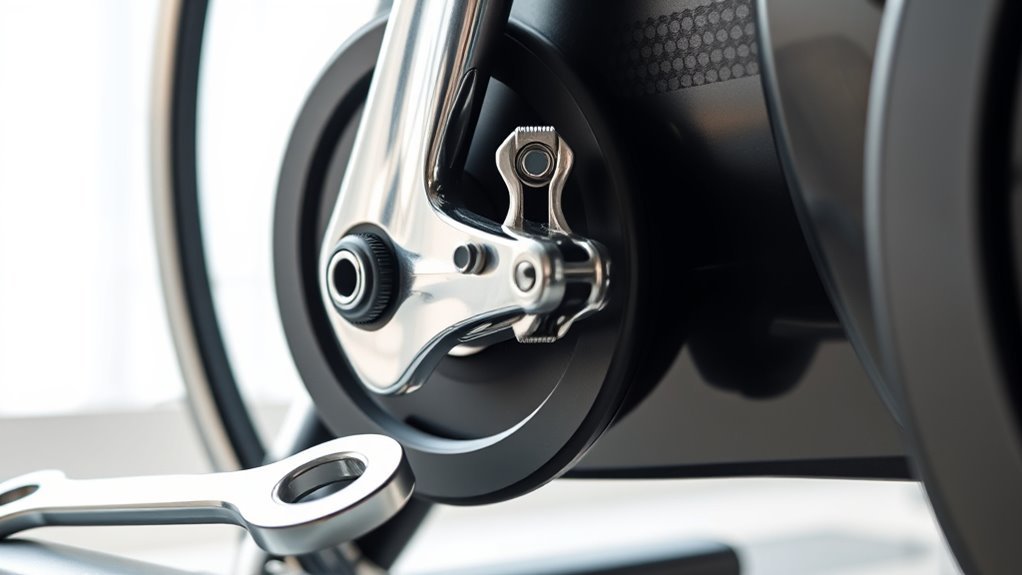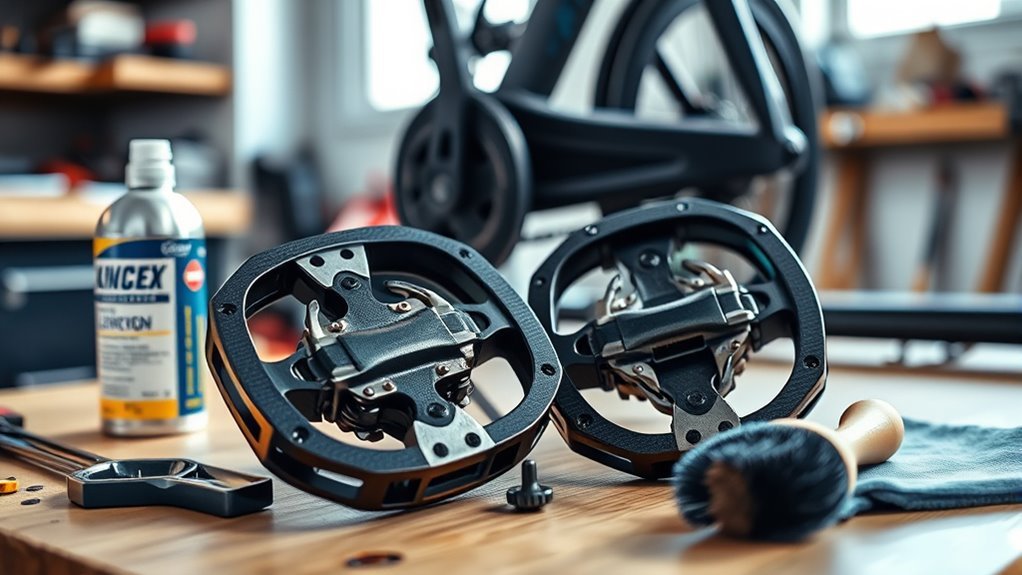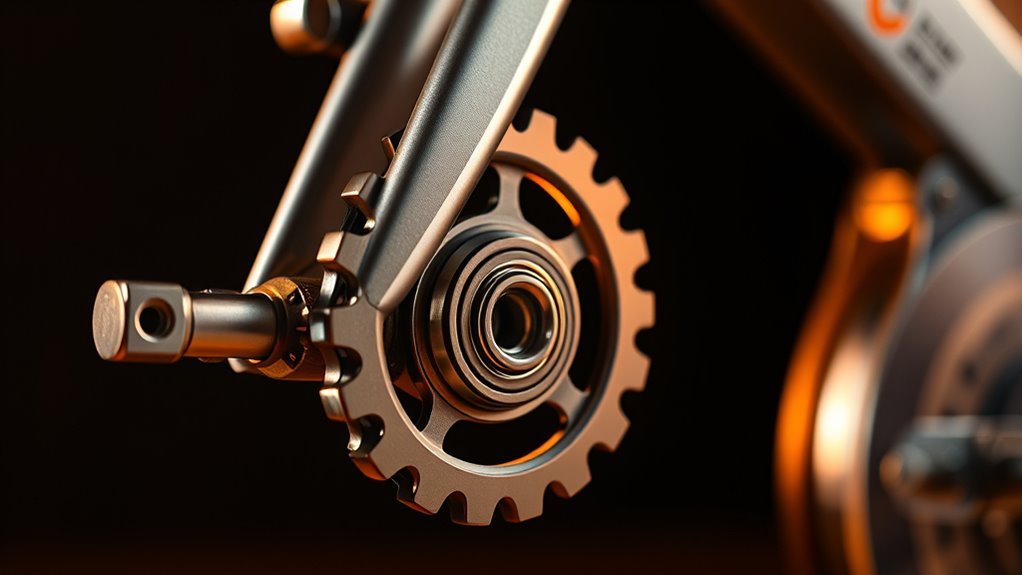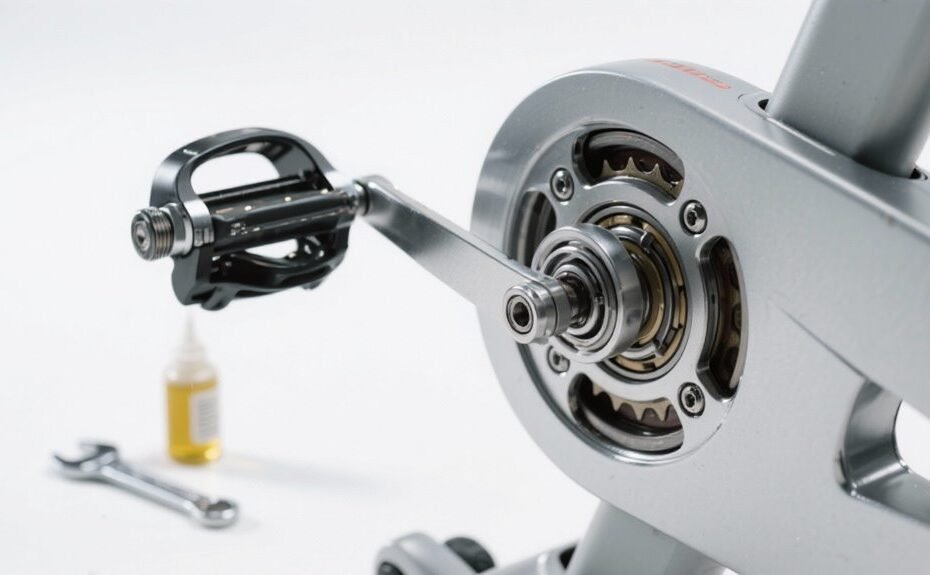Exercise bikes provide excellent cardio workouts, but that annoying squeak or creak from the pedals can turn a relaxing session into a frustrating experience. Most cyclists face this common issue at some point. The noise typically stems from loose components, lack of lubrication, or debris buildup—all fixable in just minutes with basic tools. Actually, wait—it might take a bit longer if the problem’s more complex. But who wants to exercise with that irritating sound when the solution might be simpler than expected?
Some of the links in this article may be affiliate links. If you make a purchase through these links, we may earn a small commission at no extra cost to you. Thank you.
Common Causes of Noisy Exercise Bike Pedals
The symphony of squeaks, clicks, and grinding noises from exercise bike pedals can transform a peaceful workout into an irritating ordeal.
The most common culprit? Loose pedal bolts that gradually work themselves free during intense sessions. When these connections aren’t secure, metal-on-metal friction creates that distinctive racket.
Worn-out bottom bracket bearings also frequently cause problems, especially in older bikes that haven’t received proper attention.
Actually, wait—in almost all bikes that haven’t been maintained regularly.
Regular maintenance isn’t just recommended—it’s essential. Think of it like dental flossing; skip it for too long, and problems become inevitable. Proper maintenance of the key components will help to ensure a smoother cycling experience and prevent annoying noises.
Tools You’ll Need for a Quick Fix
Just a handful of common tools are needed to silence those annoying exercise bike pedals—no need for a professional mechanic or fancy equipment. Having the right tools you’ll need makes all the difference between a quick fix and ongoing frustration. Additionally, using an exercise bike provides numerous benefits such as low-impact cardiovascular exercise that can enhance your overall fitness routine.
| Tool | Purpose | Difficulty Level |
|---|---|---|
| Pedal wrench | Tighten/remove pedals | Easy |
| Torque wrench | Secure bolts to specs | Moderate |
| Lubricating oil | Reduce friction in crank arms | Easy |
| Clean cloth | Remove debris | Easy |
| Socket set | Access bolts (helpful if you need to replace the belt) | Moderate |
Most fixes require just the wrench and some lubricant—items most homeowners already have in their toolbox.
Checking and Tightening Loose Components

Many exercise bike noise issues stem from loose hardware that requires regular inspection and proper tightening.
Applying the correct torque to crank bolts and pedal connections isn’t just about silencing squeaks—it’s essential for preventing damage and ensuring rider safety.
When installing or checking pedals, it’s important to avoid cross-threading by aligning them properly with the crank arm threads and turning counterclockwise for the left pedal, clockwise for the right. Additionally, ensuring that the bike provides a low-impact workout helps maintain your joints while using the pedals effectively.
Identify Loose Hardware
Almost all noisy exercise bike issues can be traced back to loose hardware, making this the logical starting point for troubleshooting.
When pedal threads or crank bolts aren’t properly secured, they create that annoying squeaking with each rotation.
Look for these common loose hardware culprits:
- Pedal threads that have worked themselves loose over time
- Crank bolts that need retightening to manufacturer specifications
- Connection points between pedal and crank arm
- Visible thread damage that prevents proper seating
You’ll want to systematically check each component with the appropriate tool—typically an Allen wrench or pedal wrench will do the trick.
Proper Torque Matters
Tightening bike components to the proper torque specification represents one of the most overlooked aspects of exercise bike maintenance.
Many riders don’t realize that loose pedal arm connections or improperly tightened crank bolts are often the culprits behind those annoying squeaks during workouts.
Using a torque wrench to achieve the manufacturer’s recommended 35-40 Nm setting isn’t just about preventing noise—it’s vital for performance and safety.
Before installation, clean and lubricate pedal threads to guarantee proper seating.
You’ll be amazed at how quickly a properly torqued bike transforms your riding experience from frustratingly noisy to whisper-quiet.
Cross-threading Prevention Tips
Why do so many exercise bikes end up with damaged pedal threads? It’s often due to improper installation techniques. Cross-threading prevention tips are essential for keeping your exercise bike working properly for years to come.
- Always align pedal threads carefully with crank arm threads before tightening.
- Use a pedal wrench for consistent pressure—but don’t overdo it!
- If you feel resistance, back out and realign rather than forcing it.
- Keep threads clean and add a small amount of lubricant for smoother installation.
These simple steps prevent stripped threads—probably the most common reason pedals become noisy or loose during workouts.
Proper Lubrication Techniques for Smooth Pedaling

When exercise bike pedals start making noise, proper lubrication often serves as the first line of defense against the annoying squeaks and creaks that can ruin an otherwise peaceful workout.
A penetrating lubricant like WD-40 applied to pedal threads and the crank arm can quickly silence that frustrating squeaking noise.
Be careful not to over-apply—a light coating works best to prevent dirt buildup. For persistent issues, you might need to disassemble components to reach hidden friction points.
After lubrication, always check that all bolts are tight. Establishing a regular maintenance schedule keeps your pedals running smoothly and extends the life of your exercise equipment.
Cleaning Debris From Moving Parts
Proper lubrication can work wonders for noisy pedals, but it’s only half the battle. Regular cleaning of your exercise equipment is equally essential for maintaining quiet, smooth operation.
Dirt and debris naturally accumulate in the pedal area during workouts, creating friction that leads to those annoying squeaks and creaks.
- Check the pedal threads and crank arms frequently for buildup
- Use a soft brush to clean grooves where debris often hides
- Wipe down moving parts after each workout—it only takes seconds!
- Apply light lubricant to threads after cleaning to prevent future noise
This simple maintenance routine keeps your bike running quietly and extends its lifespan considerably. Furthermore, maintaining your gym bike not only enhances its longevity but also contributes to improved heart health during your workouts.
When to Call a Professional Repair Service

Despite your best DIY efforts, some exercise bike problems simply require professional expertise. If you’re still hearing annoying clicks or squeaks after tightening pedals and lubricating moving parts, it’s probably time to call in a professional repair service.
This is especially true when the noise indicates potential issues with the bottom bracket or flywheel bearings, which often need replacement by someone with specialized tools and access to the belt system. Additionally, if you have a recumbent bike, the ergonomic design can sometimes mask underlying mechanical issues that might need a technician’s attention.
Bikes with warranty coverage should definitely be examined by pros when serious problems arise. Why risk making things worse when a technician can diagnose and fix what you can’t see?
Frequently Asked Questions
Why Does My Exercise Bike Make Noise When Pedaling?
Exercise bike noise during pedaling typically stems from loose pedals, worn bearings, or insufficient lubrication. Regular pedal maintenance tips include tightening connections and applying lubricant for effective exercise bike troubleshooting of common bike noise causes.
How to Fix Noisy Bike Pedals?
Like silent wheels of progress, noisy pedals require attention. Check and tighten all connections, apply proper bike lubrication methods to threads, inspect bottom bracket bearings, and guarantee correct alignment—essential pedal maintenance tips for noise reduction techniques.
How to Make a Stationary Bike Quieter?
Effective bike maintenance tips include lubricating pedals, tightening components, and inspecting bearings. Reducing friction through proper greasing and employing soundproofing techniques with rubber mats under the bike minimize operational noise considerably.
Why Is My Exercise Bike so Loud?
Like a parched desert dweller, exercise bikes crave lubrication. Noisy operation typically stems from dry bearings, loose pedals, or worn components. Regular pedal maintenance tips, bike lubrication techniques, and noise reduction methods prevent excessive sound.
